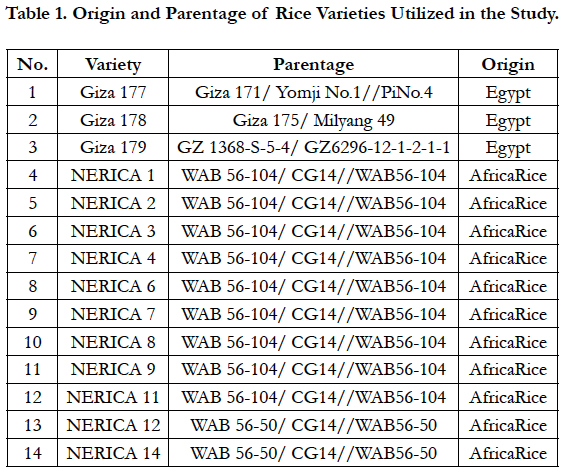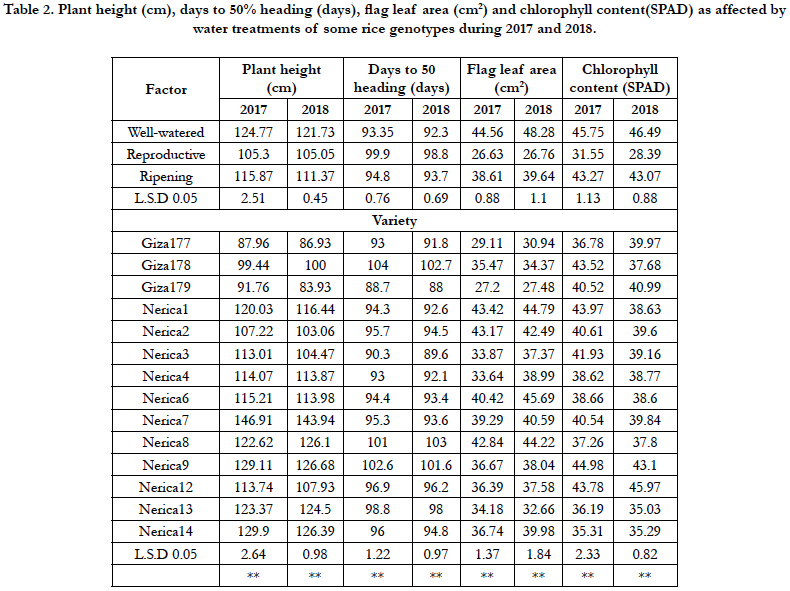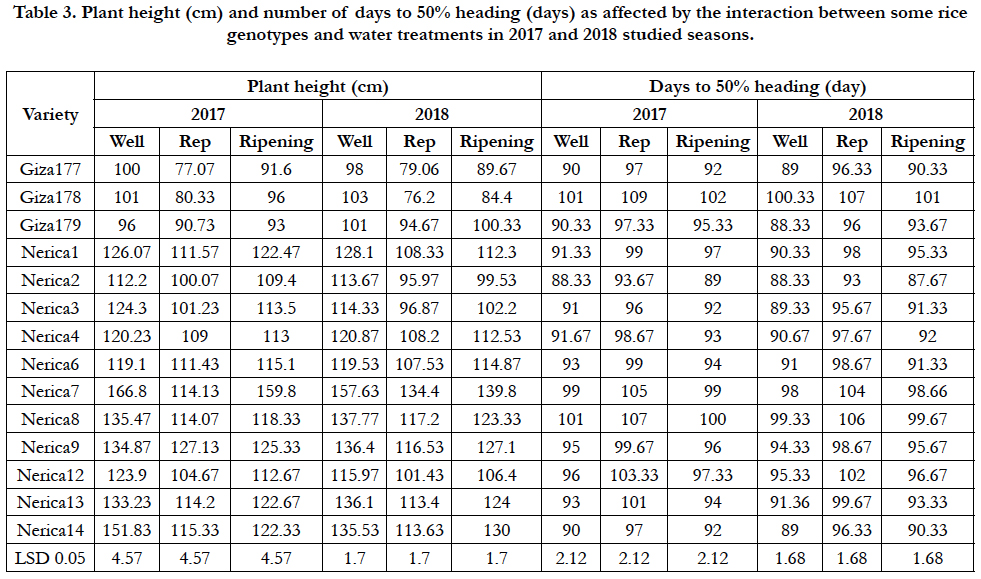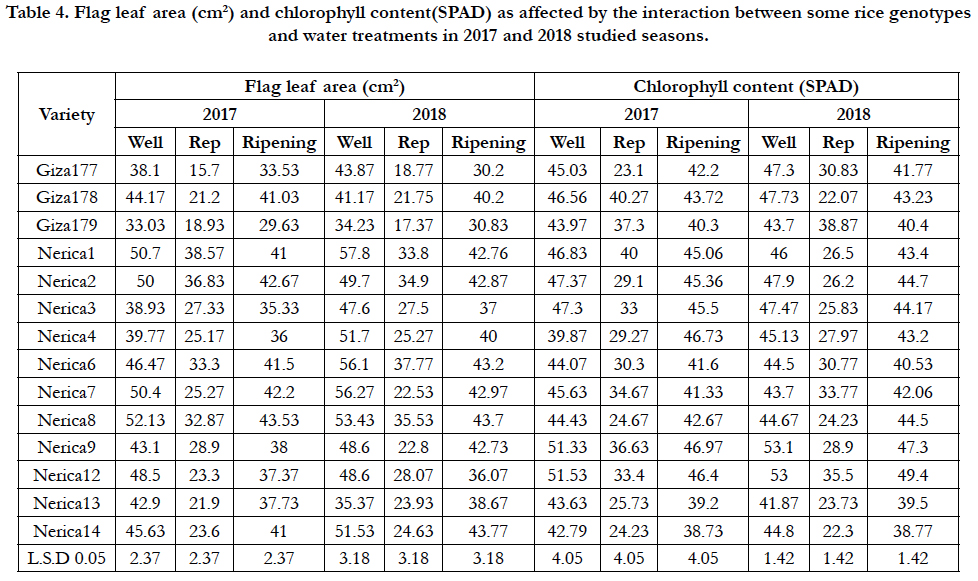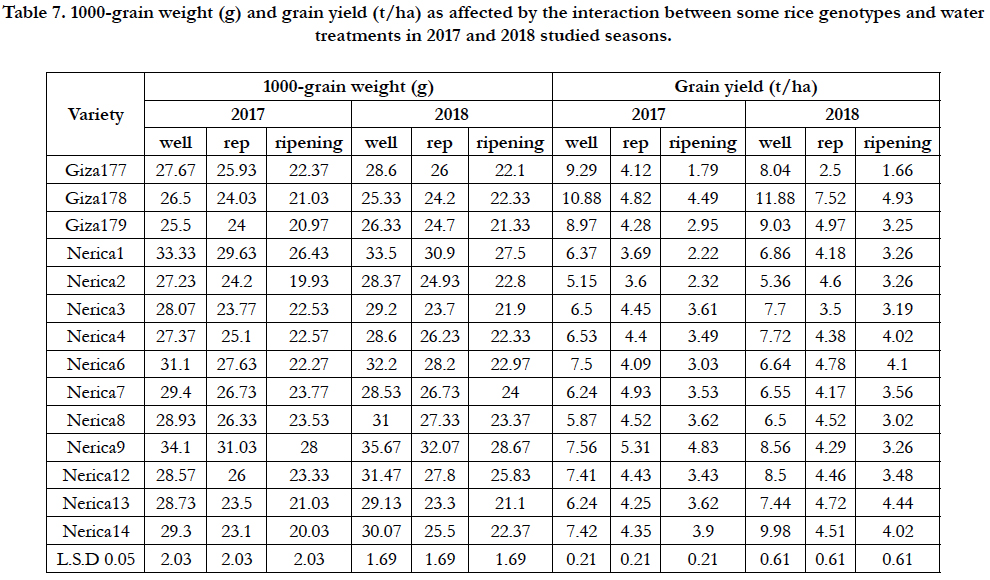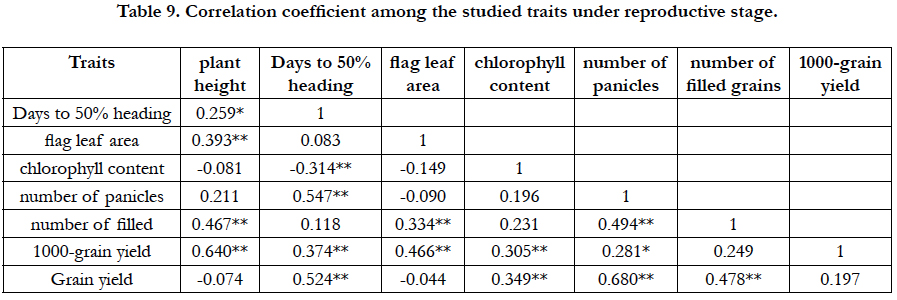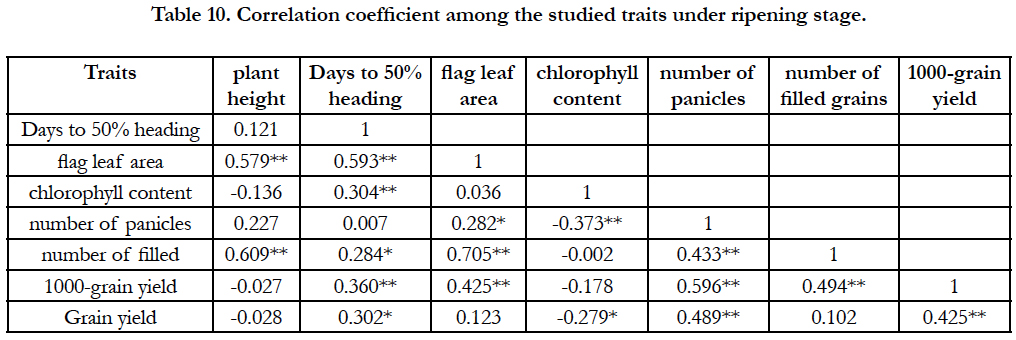Effect of Water Deficiency as Abiotic Stress on the Reproductive and Ripening Stage of Rice Genotypes
Mohamed A1, Sedeek S2*, Galal A1, Alsakka M1
1 Agronomy Department, Faculty of Agricultural, Kafrelsheikh University, Egypt.
2 Rice Research and Training Center, Field Crops Research Institute, Agricultural Research Center, Egypt.
*Corresponding Author
Saber Sedeek,
Professor, Rice Research and Training Center, Field Crops Research Institute,
Agricultural Research Center, Egypt.
Tel: +201008791697
Fax: 22354268
E-mail: 3261673349@qq.com
Received: December 24, 2018; Accepted: October 29, 2019; Published: October 31, 2019
Citation: Mohamed A, Sedeek S, Galal A, Effect of Water Deficiency as Abiotic Stress on the Reproductive and Ripening Stage of Rice Genotypes. Int J Plant Sci Agric. 2019;2(1):13-19.
Copyright: Sedeek S© 2019. This is an open-access article distributed under the terms of the Creative Commons Attribution License, which permits unrestricted use, distribution and reproduction in any medium, provided the original author and source are credited.
Abstract
Drought is one of the major a biotic stress limiting plant production in worldwide. The research work of the present study was carried out at the Experimental Farm of Sakha agricultural Research Station, Kafrelsheikh, Egypt during season of 2017 and 2018, to study the effect of water deficit at reproductive stage and ripening stage on some rice genotypes. Fourteen genotypes were used in this investigation; two of them are used as checks, NERICA 7 as tolerant to drought and Giza 177 as sensitive to drought. The results of this investigation revealed that all rice genotypes and their traits were affected significantly by drought stress at reproductive stage and ripening stage. The drought stress at reproductive stage reduced significantly plant height, number days to complete heading, flag leaf area, chlorophyll content and number of panicles hill. while, the drought stress at ripening stage decline significantly the number of filled grains panicle-1 and 100-grain weight and grain yield t/ha. The reduction in grain yield due to drought at ripening stage is 52 and 55 % compared with well-watered in 2017 and 2018.While, the reduction in grain yield attributed to water stress at reproductive stage is 42 and 42.9% in both seasons of research. All rice varieties were affected significant by drought stress at ripening stage followed by the drought stress at reproductive stage. The reduction in grain yield its differed among the rice varieties according to their level of tolerance, the reduction in grain yield due to drought stress at both ripening and reproductive stage for the sensitive variety Giza 177 was about 80.7 and 55% compared with well-watered. While, the lowest reduction percentage in grain yield under the same conditions were recorded for NERICA 7 and NERICA 8. Grain yield was positively correlated with chlorophyll content, number of panicles per hill, number of filled grains per panicle under well-watered and water stress at reproductive stage. Also, highly significant and positive correlation between grain yield and each of number of panicles and 1000-grain weight under water stress at ripening stage.
2.Introduction
3.Materials and Methods
4.Results and Discussion
4.1 Plant Height
4.2 Days to Complete Heading
4.3 Flag Leaf Area
4.4 Chlorophyll Content
4.5 Number of Panicles Plant-1
4.6 Number of filled Grains Panicle-1
4.7 1000-Grain Weight
4.8 Grain Yield (t/ha)
4.9 Correlation Coefficients Analysis
5.Conclusion
6.References
Keywords
Rice; Drought Effects; Reproductive and Ripening Stages.
Introduction
Egypt is facing two major challenges i.e. food security and water shortage, particularly in the terminal areas. Water shortage is one of the most limiting factors in more than 30% of paddy fields in Egypt, where the developed varieties cannot perform well under water shortage [1]. The world population is expected to reach 9 billion by the middle of the twenty-first century. In many crops, particularly cereals, the plants are more sensitive to drought stress during the reproductive phase than at any other time, except early establishment while the root system is developing [18]. Water deficit is a major problem for crop production worldwide, limiting the growth and productivity of many crop species, especially in rain-fed agricultural areas (>1.2 billion hectares) (2; 15). Drought is one of the most important abiotic stresses causing drastic reductions in yield in rainfed rice environments. Large areas of rice are grown under lowland and upland rainfed conditions, these areas respectively occupy 31 and 11% of the global rice growing area [7]. Drought is one of the major a biotic stress limiting plant production in rainfed ecosystem. (Evensonet al., 1996) [3] estimated global rice grain yield lost due to drought to be 18 million tons annually or 4% of total rice production, which was valued conservatively at US$ 3.6 billion at that time. Selection for lines that maintain high spikelet fertility under drought stress and/or a low rate of leaf drying under drought stress is also common [9]. Drought tolerance is the most important characteristic in upland rice breeding. Various evaluation have been reported for the estimation of drought tolerance based on plant body symptoms caused by water deficit, such as plant wilting, leaf rolling and yield loss [4, 10]. The objectives of this investigation to identify drought tolerant rice variety and to evaluate the effect of water stress on some of rice genotypes at reproductive stage and ripening stages.
Materials and Methods
The research work of the present study was carried out at the Experimental Farm of the Rice Research and Training Center (RRTC), Sakha, Kafr EL-Sheikh, Egypt, during the two successive rice seasons 2017 and 2018 to study the effect of water stress on yield and its components for some rice genotypes at different reproductive and ripening growth stages of rice. 14 genotypes, 11 upland rice varieties were introduced from Africa Rice and 3 Egyptian commercial varieties were chosen for this study. These genotypes have a wide range of variation due to their different genetic background. The pedigree, group type and main characters of these varieties are illustrated in Table (1). The 14 rice genotypes utilized in this study were grown in two successive seasons in 2017 and 2018. Seeds of the 14 rice genotypes were grown in the first week of May during 2017 and 2018 rice seasons and seedlings were transplanted individually after 30 days with a spacing of 20 x 20 cm.
Statistical design of the experiment was split plot design. Rice varieties were applied in the sub plots and water treatments were allocated in the main plots under the well-watering and water stresses. Each replication included seven rows for each genotype, the length of each row were 5m, and harvested 5m2. The irrigation continue in well-watered replications until the end of the experiment and always keep on moisture at saturated or above the field capacity. For water stress, two consecutive cycles of stress was applied at reproductive stage (after 45 days of transplanting) for 15 days with holding till appear the drought susceptibility traits (leaf rolling and leaf drying score) on the tolerant variety and irrigated after water stress up to harvest. While, the second water stress was applied at ripening stage (after complete heading) for 15 days then irrigated up to harvest. The rate of NP 60: 30 Kg/ha applied as follows; 60 kg N/ha in the form of urea (46.5%N) was applied in two splits, the first dose 2/3 added as basal application and incorporated with soil during land preparation for fully irrigated and water stress replications. While, the second dose was top-dressed after 30 days of transplanting, 30 kg P2O5/ha in the form of single super phosphate (15% P2O5) was applied in the permanent field and incorporated with soil during land preparation for fully irrigated and water stress replications. All recommended agricultural practices were applied as usual for the ordinary rice field. Weeds were chemically controlled. The following traits were recorded i.e., Plant height (cm), Number of Days to heading (days), Flag leaf area (cm2), Chlorophyll content, Number of panicles/plant, Number of filled grains/panicle, 1000-grain weight (g) and Grain yield t/ha was measured according to IRRI, 1996. The relationships among the studied characters were assessed statistically through simple correlation, following (Gomez and Gomez, 1983) [5] using SPSS version 16 for windows.
The plant height reduced significantly with drought stresses at reproductive and ripening stages compared with well-watering Table 2. The lowest values of plant height were recorded with water stress at reproductive stage. All rice varieties differed among them in their response to water stress according to their level of tolerance and their genetic background. NERICA 7 showed the tallest plants while, the Egyptian rice varieties Giza 177, Giza 179 and Giza 178 exhibited the shortest plants in both seasons of investigation Table 3. The negative effect of drought on plant height may due to poor root development; reduce leaf surface, increase leaf senescence and inhibition of stem reserves. The same trend of results of drought effect on plant height was reported by (Marie-Noelle etal,. 2010) [12].
Table 2. Plant height (cm), days to 50% heading (days), flag leaf area (cm2) and chlorophyll content(SPAD) as affected by water treatments of some rice genotypes during 2017 and 2018.
Table 3. Plant height (cm) and number of days to 50% heading (days) as affected by the interaction between some rice genotypes and water treatments in 2017 and 2018 studied seasons.
The number of days to complete heading was increased under water stresses at reproductive stage and ripening stage compared with well-watering Table 2. (Hong and Serraj, 2012) [6] found that the peduncle elongation rate was significantly inhibited by drought, simultaneously with the decrease of plant water status parameters.
The data in Table 3 indicated that the number of days to complete heading was increased due to drought stress. Drought stress applied at the beginning of the reproductive stage usually results in a delay in flowering, [17]. This is mainly due to slowed elongation of the panicle and supporting tissues [11, 14] reported that the delay in flowering under drought is a consequence of a reduction in plant dry-matter production and of a delay in panicle exsertion. The delays in flowering and maturity could be considered as good indicators in drought screening tests since the effect of drought on the trait was consistent. All rice varieties were affected by drought stress and the affected was differed based on the nature of genetic of each variety and its tolerance. All rice varieties were delay in flowering under water stress compared with well-watered.
The water stress affected significantly on the flag leaf area for all rice varieties under study it recorded 26.63 cm2 at reproductive stage followed by the drought stress at ripening stage while the highest values of flag leaf area was recorded under well-watered 44.56 cm2. The reduction in the flag leaf area due to drought stress mainly attributed to .the rice genotypes differed in their flag leaf area according to the nature of each variety Table 2.
The flag leaf area for all rice varieties were affected significantly by water stresses at reproductive and ripening stage. The reduction in the flag leaf area differed among the rice varieties according to their levels of tolerance; the reduction in the flag leaf area was high under reproductive stage compared with ripening stage and well-watered Table 4. Giza 177 showed the lowest value of flag leaf area under reproductive stage 15.7 cm2 compared with the area under ripening and well-watered 33.53 and 38.1 cm2.
The degradation in the chlorophyll content was higher at reproductive stage than at ripening and well-watered treatments as shown in Table 2. The lowest value was obtained with water stress at reproductive stage 31.55 and 28.39 SPAD in 2017 and 2018 while the highest values were observed with well-watered treatment in both seasons Table. The reduction in chlorophyll content due drought stress at reproductive stage was high for all rice varieties followed by the stress at ripening stage and wellwatered Table 4. Drought affected chlorophyll content. Such a stress influence plant growth by suppressing cell enlargement and cell division, by reducing cell turgor, photosynthesis rate, metabolic and assimilate processes, pigment formation, and water and nutrients uptake as well as the transportation of organic solutes from one organ to another in the rice plant.
Table 4. Flag leaf area (cm2) and chlorophyll content(SPAD) as affected by the interaction between some rice genotypes and water treatments in 2017 and 2018 studied seasons.
The data in Table revealed that the number of panicles was affected by water stress at reproductive stage followed by ripening stage and well-watered Table 5.
The sensitive Giza 177 recorded the lowest value of number of panicles under water stress at reproductive stage in the both season of study. While Giza 179 gave the highest value under the same conditions Table 6.
Table 5. No. of panicles/plant, no. of filled grains/panicle, 1000-grain weight (g) and grain yield (t/ha) as affected by water treatments of some rice genotypes during 2017 and 2018.
Table 6. No.of panicles/plant and no.of filled grains/panicle as affected by the interaction between some rice genotypes and water treatments in 2017 and 2018 studied seasons.
The lowest values of number of filled grains panicle-1 was recorded under ripening stage in both seasons followed by water stress at reproductive stage compared with well-watered gave the highest values Table 5. NERICA 7 gave the highest values of number of filled grains panicle-1 under water stresses at ripening and reproductive stage of rice, respectively. On the other hand the Egyptian rice variety Giza 177 recorded the lowest values under the same conditions Table 6.
The water stress at ripening stage gave the light grains in both seasons 2017 and 2018 then the water stress at reproductive stage. While well-watered treatment gave the highest values. The rice varieties were affected significantly due to water stress at ripening and reproductive stage and the reduction in 1000-grain weight differed according to the nature of each variety and its level of tolerance Table 7.
Table 7. 1000-grain weight (g) and grain yield (t/ha) as affected by the interaction between some rice genotypes and water treatments in 2017 and 2018 studied seasons.
The data in Table 5 shows that the highest grain yield t/ha was obtained with well watered while the lowest values of grain yield was recorded under ripening and reproductive stage respectively Table 5. The reduction in grain yield due to drought at ripening stage is 52 and 55 % compared with well-watered in 2017 and 2018 while, the reduction in grain yield attributed to water stress at reproductive stage is 42 and 42.9% in both seasons of research Table 7. Hong and Serraj 2012 reported that the reduction in grain yield due drought stress at reproductive stage about 20% of that of the control.
All rice varieties were affected significant by drought stress at ripening stage followed by the drought stress at reproductive stage. The reduction in grain yield its differed among the rice varieties according to their level of tolerance, the reduction in grain yield due to drought stress at both ripening and reproductive stage for the sensitive variety Giza 177 was about 80.7 and 55% compared with well-watered. While, the lowest reduction percentage in grain yield under the same conditions were recorded for NERICA 7 and NERICA 8 Table 7. Raumjit and Teerayut (2014) state that when drought condition occurred during vegetative and reproductive stages, it decreased in yield of up to 30% was due to reduced panicle number per unit area.
The data in Tables 8, 9 and 10 showed the correlations among the plant characteristics under control and drought stress at reproductive and ripening stages of rice. Grain yield was positively correlated with chlorophyll content, number of panicles per hill, number of filled grains per panicle under well-watered and water stress at reproductive stage. Also, highly significant and positive correlation between grain yield and each of number of panicles and 1000-grain weight under water stress at ripening stage. Whereas it was negatively correlated with plant height and flag leaf area under well-watered. This is in accordance with findings of Masakata et al., (2006), Marie-Noelle et al., (2010) [12] and Sedeek et al., 2017 [19].
Conclusion
The results of this investigation revealed that all rice genotypes and their traits were affected significantly by drought stress at reproductive stage and ripening stage. The drought stress at reproductive stage reduced significantly plant height, number days to complete heading, flag leaf area, chlorophyll content and number of panicles hill. while, the drought stress at ripening stage decline significantly the number of filled grains panicle-1 and 1000-grain weight and grain yield t/ha. The reduction in grain yield its differed among the rice varieties according to their level of tolerance.
References
- Allah AA. Development of some high yielding rice lines tolerant to drought stress conditions. Journal of Medicinal Plants Research. 2010; 4(7):528-35.
- Chaves MM, Oliveira MM. Mechanisms underlying plant resilience to water deficits: prospects for water-saving agriculture. J Exp Bot. 2004; 55: 2365–2384.
- Evenson RE, Herdt RW, Hossain M, editors. Rice research in Asia: progress and priorities. IRRI, Wallingferd, UK. 1996; 210-220.
- Gupta PC, O'Toole JC. Upland rice: a global perspective. Int. Rice Res. Inst. 1986; 148-174.
- Gomez KA, Gomez AA. Statistical procedures for agricultural research. John Wiley & Sons; 1984 Feb 17.
- He H, Serraj R. Involvement of peduncle elongation, anther dehiscence and spikelet sterility in upland rice response to reproductive-stage drought stress. Environmental and Experimental botany. 2012 Jan 1; 75:120-7.
- International Rice Research Institute. 2001. Rice ecosystem Table 30. Distribution of rice crop area (000 ha), by environment, 2001.
- IRRI. International Rice Research Institute Descriptors for Rice. Los Banos, Laguna, Philippines. 1996; 52.
- Jongdee B, Pantuwan G, Fukai S, Fischer K. Improving drought tolerance in rainfed lowland rice: an example from Thailand. Agricultural Water Management. 2006 Feb 24; 80(1-3):225-40.
- Kon T. Drought tolerane. Nogyogijutsu. 1990; 45: 422-427 (in Japanese).
- Lafitte HR, Ismail A, Bennett J. Abiotic stress tolerance in rice for Asia: progress and the future. InProceeding of 4th International Crop Science Congress, Brisbane, Australia. 2004 Sep 26; 1137.
- Ndjiondjop MN, Cisse F, Futakuchi K, Lorieux M, Manneh B, Bocco R, et al. Effect of drought on rice (Oryza spp.) genotypes according to their drought tolerance level. In Second Africa Rice Congress, Bamako, Mali. 2010 Mar; 1: 1-1.
- Hirayama M, Wada Y, Nemoto H. Estimation of drought tolerance based on leaf temperature in upland rice breeding. Breeding Science. 2006; 56(1):47- 54.
- Murty KS, Ramakrishnayya G. Effect of drought on shoot growth, significance of metabolism to growth and yield. Drought Resistance in Crops with Emphasis on Rice, International Rice Research Institute, Los Ba nos, Manila, Philippines. 1982:145-52.
- Passioura J. The drought environment: physical, biological and agricultural perspectives. Journal of experimental botany. 2006 Nov 22; 58(2):113-7.
- Nokkoul R, Wichitparp T. Effect of drought condition on growth, yield and grain quality of upland rice. American Journal of Agricultural and Biological Sciences. 2014; 9(3):439-44.
- Saini HS, Westgate ME. Reproductive development in grain crops during drought. In Advances in agronomy 1999 Jan 1; 68: 59-96.
- Salter PJ, Goode JE. Crop responses to water at different stages of growth. Crop responses to water at different stages of growth. 1967.
- Sedeek S, R. El-Namkay, TF Metwally, MH Ammar. Characteristics of the NERICA and local rice varieties under rainfed upland conditions in Tanzania. Egypt. J. Plant Breed. 2017; 21(5): 49-60.

